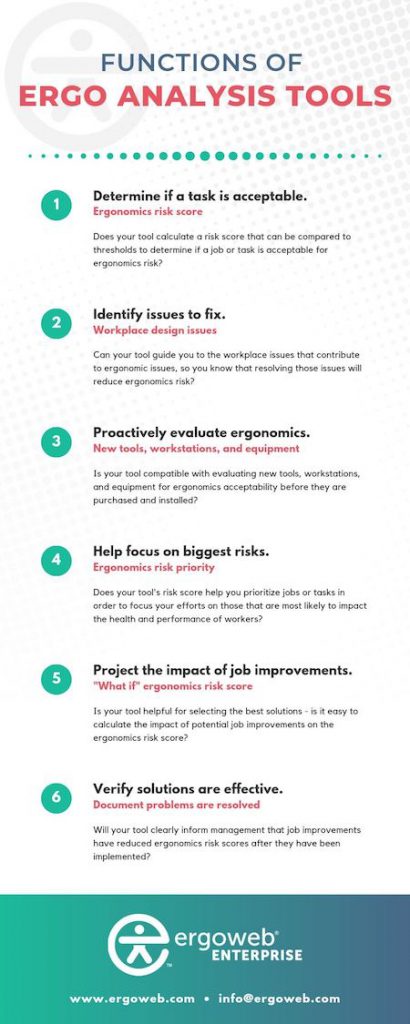
Ergonomics is an improvement process that, when successful, achieves meaningful outcomes such as less muscle fatigue, increased productivity, and reduced number and severity of work-related MSDs (from OSHA’s Ergonomics page). Ergonomics analysis tools are useful when they support a successful improvement process, such as:
- Helping you determine if a specific job or task is acceptable in terms of ergonomics risk
- Identifying the workplace design issues that are contributing to ergonomic risk (and therefore need to be addressed to reduce the ergonomics risk score)
- Providing a means to evaluate if new tools, workstations, or equipment are ergonomically acceptable before they are approved
- Prioritizing ergonomics risk exposure so you can focus on the jobs that are most likely to negatively impact the health and performance of workers
- Projecting the potential impact of job improvements so you can select the appropriate solutions that will reduce ergonomic risk
- Verifying that job improvements meaningfully reduce the ergonomics risk after they are implemented
When an ergonomics improvement process is stalled and not achieving meaningful outcomes, it’s sometimes because the chosen suite of ergonomic analysis tools isn’t fitting the needs of the team. The two common frustrations we hear about are:
- Ergo analysis tools are too sensitive, so nearly every job comes out as high risk, and still show as high risk after improvements are implemented
- Analysis tools don’t provide insight into what the workplace design issues are that need to be changed in order to reduce the ergonomics risk score
These frustrations are nearly universal when the jobs are non-repetitive or non-routine. If that’s your issue, you might want to read our short article on Improving Ergonomics in Non-Repetitive Jobs or download Ergoweb’s Guide to Assessing Ergonomic Risk of Non-Cyclical Work.
If your ergonomics process is stalled and you suspect you might not be using the best ergo analysis tools for your purpose, take a look at the suite of tools you’re using and consider if it’s helping or hindering your progress. Download Ergoweb’s Guide to Picking the Best Ergo Analysis Tool for the Job to learn about the strengths and weaknesses of 16 industry-standard ergonomics analysis tools.
